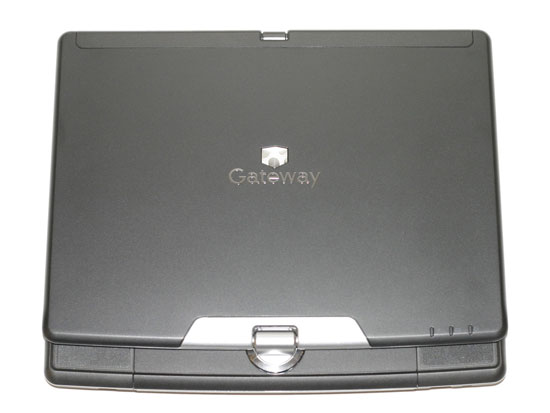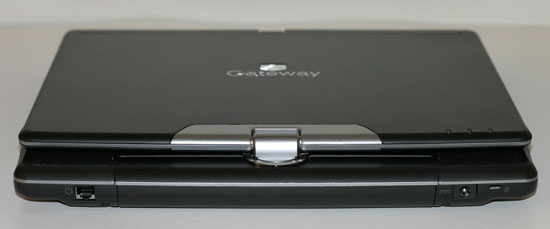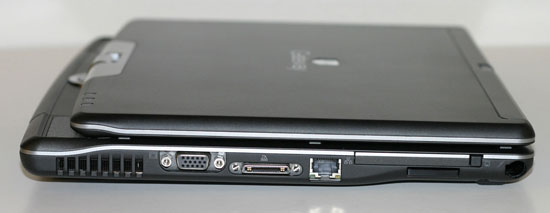Gateway E-155-C: A Lightweight Convertible
by Jarred Walton on July 4, 2007 12:05 AM EST- Posted in
- Laptops
Design and Appearance
Performance, features, size, and/or weight are usually the primary considerations for people out notebook shopping. Appearance is another factor that may or may not be important, and the overall design needs to be evaluated to see how it works in day-to-day use.
We would characterize the appearance in general as utilitarian. It's not really ugly, but at the same time there's nothing to set it apart from other notebooks. You get a charcoal gray laptop that looks about the same as many other laptops. Those who are looking for a beauty queen will want to keep searching, but before you write off the E-155-C you might want to take a closer look at the design.
One of the selling points is that you can convert the E-155-C from a standard laptop into a tablet PC. (Note that in the above image the laptop is technically upside down; the screen orientation is automatically flipped when you convert the system into tablet mode, but we liked having the Gateway logo right side up.) The E-155-C might be thicker than a pure-tablet design, but we would be hard-pressed to give up access to a keyboard on any computer. Perhaps a combination of using a tablet interface along with speech recognition could suffice, but we did try exactly that and came to the conclusion that there are still plenty of times where having access to a keyboard and mouse is practically a necessity.
Looking at the laptop from various angles, we can see many of the features highlighted on the previous page. There are no ports or connections on the front of the laptop. The only item worth mentioning is the button that releases the display. The latch for the display can be flipped either direction so that it will also lock into place in tablet mode.
The rear is similarly barren. On the right side (left when you're facing the front of the laptop) is the power socket and Kensington lock, while on the other side is a telephone jack. (Our condolences if you still have to use such a connection.) The battery slides out of the back of the unit, and the larger battery sizes protrude slightly farther than what you see in the above image. The battery design actually works very well, and using a larger battery doesn't make the notebook any more awkward to handle. This is not the case with some other notebooks, where larger batteries can end up protruding from the bottom of the case and give the laptop a bulky feel.
The left and right sides as usual house the majority of the connections. On the left you will find a VGA port, the docking connector, Ethernet, a PC Card type II expansion slot, and a 6-in-1 flash memory reader (MS/MS Pro, MMC/RS-MMC, SD/Mini-SD). While the inclusion of an older PC Card slot as opposed to a new ExpressCard slot seems a bit odd at first, the primary market for the E-155-C appears to be business users, and many large corporations and businesses have various PC card peripherals that they continue to use. Near the front of the laptop, we also find the home for the stylus.
The right side houses the optical drive, which takes up the majority of the space. Near the rear are microphone and headphone jacks, while towards the front are two USB ports and a mini FireWire port.
Performance, features, size, and/or weight are usually the primary considerations for people out notebook shopping. Appearance is another factor that may or may not be important, and the overall design needs to be evaluated to see how it works in day-to-day use.
 |
We would characterize the appearance in general as utilitarian. It's not really ugly, but at the same time there's nothing to set it apart from other notebooks. You get a charcoal gray laptop that looks about the same as many other laptops. Those who are looking for a beauty queen will want to keep searching, but before you write off the E-155-C you might want to take a closer look at the design.
 |
One of the selling points is that you can convert the E-155-C from a standard laptop into a tablet PC. (Note that in the above image the laptop is technically upside down; the screen orientation is automatically flipped when you convert the system into tablet mode, but we liked having the Gateway logo right side up.) The E-155-C might be thicker than a pure-tablet design, but we would be hard-pressed to give up access to a keyboard on any computer. Perhaps a combination of using a tablet interface along with speech recognition could suffice, but we did try exactly that and came to the conclusion that there are still plenty of times where having access to a keyboard and mouse is practically a necessity.
 |
 |
Looking at the laptop from various angles, we can see many of the features highlighted on the previous page. There are no ports or connections on the front of the laptop. The only item worth mentioning is the button that releases the display. The latch for the display can be flipped either direction so that it will also lock into place in tablet mode.
The rear is similarly barren. On the right side (left when you're facing the front of the laptop) is the power socket and Kensington lock, while on the other side is a telephone jack. (Our condolences if you still have to use such a connection.) The battery slides out of the back of the unit, and the larger battery sizes protrude slightly farther than what you see in the above image. The battery design actually works very well, and using a larger battery doesn't make the notebook any more awkward to handle. This is not the case with some other notebooks, where larger batteries can end up protruding from the bottom of the case and give the laptop a bulky feel.
 |
 |
The left and right sides as usual house the majority of the connections. On the left you will find a VGA port, the docking connector, Ethernet, a PC Card type II expansion slot, and a 6-in-1 flash memory reader (MS/MS Pro, MMC/RS-MMC, SD/Mini-SD). While the inclusion of an older PC Card slot as opposed to a new ExpressCard slot seems a bit odd at first, the primary market for the E-155-C appears to be business users, and many large corporations and businesses have various PC card peripherals that they continue to use. Near the front of the laptop, we also find the home for the stylus.
The right side houses the optical drive, which takes up the majority of the space. Near the rear are microphone and headphone jacks, while towards the front are two USB ports and a mini FireWire port.










25 Comments
View All Comments
elom - Wednesday, April 2, 2008 - link
This deal has been horrible for the companies that had existing warrenties with Gateway. MPC has still yet to get there act together and it is now April. My company has had 28 of these machines down since the begining of the year and only half have been fixed. I have NBD on-site service and I am not seeing anywhere close to that. I am moving to another PC manufacturer ASAP.tacoburrito - Wednesday, July 4, 2007 - link
With the 6 cell battery, this thing will weight over 5 lbs. Not really an ultra-portable in the classical sense, is it? But it seems this is what we have to put up with if one wants the Tablet features. Lenovo, Toshiba, and HP already have sub-3lbs notebooks in their catalouge running similar specs to the Gateway. Can you review those instead, if you want to do an ultra-portable review?JarredWalton - Wednesday, July 4, 2007 - link
As always, we review what we get sent. Needless to say, I'm not about to go out and spend $2000 on a notebook just to provide free press for a company. I've tried to get in touch with Lenovo, without much success. I'm working to get some stuff from Toshiba and HP that falls in the ultraportable range, so we'll see.Honestly, I'm not quite sure why the notebook is so heavy relative to others. The case does feel pretty durable, however, so that's probably a large part of the weight question. The display doesn't really feel much heavier than a normal laptop LCD - certainly not more than a few ounces. Anyway, lightweight and flimsy may not be the right way to go either - I'd probably take the extra pound if it means the display hinges and other parts don't break after a year or two.
bldckstark - Friday, July 6, 2007 - link
I'm disappointed to see that Lenovo hasn't responded to your requests. I would really like to see their V and X series ultraportables up against the competition.I bought my wife the Lenovo V series laptop that is almost an exact twin of the Gateway reviewed here, with the exception of the convertible screen. It is quicker than my desktop 3800+, weighs 4.4lbs with the 6 cell battery, and gets 255 mins runtime on, all for $1,250. It really puts the Gateway to shame. At least this time I didn't buy an expensive piece of electronics just to go online a month later to see a review of a cheaper, faster, better device that makes me want to throw up.
What I can't compare at home though is the LCD screen quality versus the Gateway. I would like to see if the Lenovo screens are better, worse, same. Especially on the V series versus the X/T series.
This makes me really want to see the Lenovo T60 reviewed to see how much dust the Gateway would be eating.
jonp - Friday, July 20, 2007 - link
I'd vote to add a Lenovo T61, p/n 7662 with the T7500 CPU, 2GB RAM, 7200rpm hard drive, XP Pro to a future review.Athlex - Wednesday, July 4, 2007 - link
Any chance of getting a photo of the keyboard and touchpad/trackpoint?Baffling that laptop manufacturers are putting "docking" ports on the sides of notebooks instead of the bottom. HPQ seems to be doing the same thing on their consumer stuff.
JarredWalton - Wednesday, July 4, 2007 - link
Sorry about that - I actually had the image on our server but forgot to update the first page before the article went live.I'm also a bit baffled about the docking port on the side... but then I don't see much reason for docking stations these days. All I really need is mouse, keyboard, and display - if I want more than that from a laptop, I'd probably get a nicer laptop rather than worrying about spending the money for a docking station.
strikeback03 - Thursday, July 5, 2007 - link
If you connect keyboard/mouse/monitor every day (or multiple times a day) it is probably convenient to only have to make one connection instead of 3. also, some docking stations offer ports the laptop does not - for example, most (if not all) thinkpad docking stations have DVI ports even though the laptop itself does not.One reason this might be heavier than other tablets is the included optical drive - lots of the ~3lb ones ditch that, and the whole case can shrink as a result.
JarredWalton - Thursday, July 5, 2007 - link
Gateway does list the laptop as weighing .3 lbs less with a "weight saver" - I'm guessing a plastic piece that fills the ODD slot. I do have to say that ditching the DVD - except you would have an external unit - isn't a good move IMO. That's just marketing trying to cut weight at all costs. I suppose I could live without a DVD in a pinch, but I really wouldn't want to.People that will spend $200+ to save themselves two connections are a bit out there, I'd say. The DVI port could be useful, but plenty of laptops have those anyway. Heck, ditch the docking port connector and give us DVI and we'd be set. Heh.
Verdant - Wednesday, July 4, 2007 - link
a lot of people seem to refer to the screens as "touch screens" i thought they used some sort of circuit that involved the stylus. Do tablets have a "touch" or "digitizer stylus" screen? Or do both exist?Personally i would prefer non-touch screen as writing on those can be difficult with my left-handedness.